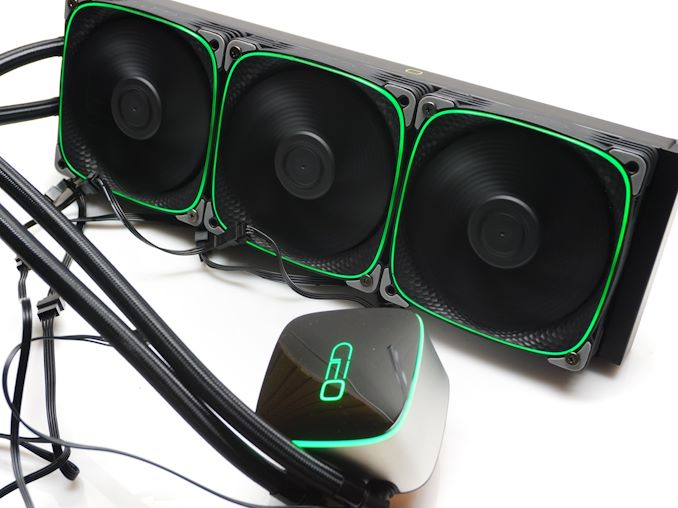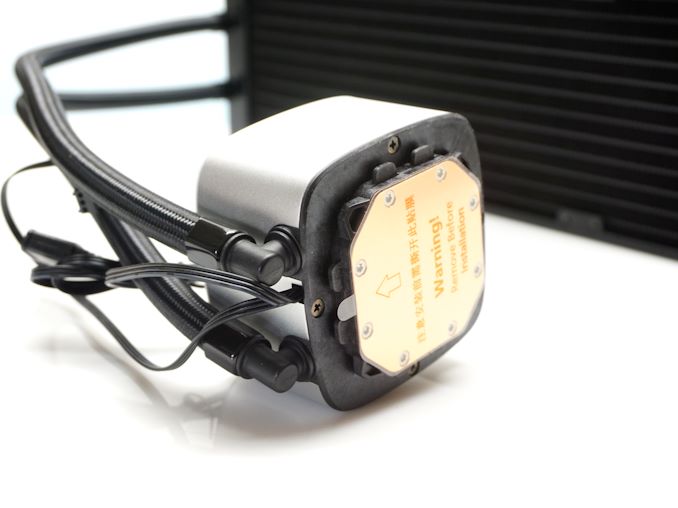The Geometric Future Eskimo Junior 36 AIO Cooler Review: Subdued Minimalism
by E. Fylladitakis on February 8, 2024 8:00 AM ESTConclusion
The Geometric Future Eskimo Junior 36 AIO Liquid Cooler, priced at $120, stands as a capable cooler within what's already a highly-competitive market. Suitable for enthusiasts and regular users alike, the Eskimo balances price with performance and aesthetics, making it an attractive option for a wide range of builds. Its sleek design features a minimalist aesthetic and a subtle implementation of RGB lighting, offering something that, at least visually, is distinct from the many other AIO coolers on the market.
In terms of design, the Eskimo Junior 36 basically adheres to the standard AIO layout but distinguishes itself with its simplicity. The inclusion of black sleeved, flexible rubber tubing complements both its visual and functional aspects. The main block, with its sleek metal surround and subtle RGB lighting, provides a touch of elegance. The radiator is of basic design and the etched company logo on its sides is practically invisible but the Squama fan and especially the application of RGB lighting is visually outstanding.
Performance-wise, the Eskimo Junior 36 shows its strength in offering consistent cooling with minimal noise, with very good thermal performance figures at lower fan speeds. While it does not outperform most of its direct competition, its thermal performance is competitive and does manage to surpass a few rival products. While it may not significantly improve in thermal performance at higher airflows, this cooler is an ideal choice for typical users who seek effective cooling with limited noise.
At its $120 price point, the Geometric Future Eskimo Junior 36 is currently positioned as a competitive option in the mid-range cooling market. Its blend of performance, aesthetics, and affordability should make it a solid choice for a variety of PC builds. Arguably, the strongest selling point of the Eskimo Junior 36 is its outstanding aesthetics; the cooler's understated design, coupled with its effective cooling capabilities, ensures that it not only performs well but also enhances the overall look of the system. For users seeking a fair balance between cost, performance, and aesthetics, the Eskimo Junior 36 emerges as another interesting option in the realm of AIO liquid coolers.












38 Comments
View All Comments
m3city - Friday, February 9, 2024 - link
It would be great if charts included thermal & noise values for a reference (stock) air cooler. This is what holds my wallet in my pocket - I don't know what I will achieve with addition of a water cooler. Less noise?back2future - Friday, February 9, 2024 - link
[ improved (lower) heat resistance value from cpu&metalShielding towards ambient surroundings air (without additional case fans), therefore (probably, mostly) lower rpms from (2-)3 cooler fans or more headroom for power demand with a water pump providing sufficient flow for the water liquid (and enough surface area for the metal to water heat exchanger on top of the cpu), additionally one could add other sockets or chipsets or storage cooling demand to one cooling system, for the cost/price its about a decision for ~$15-20 quality fan(s) or a water cooler system (this) ~$120, durability comparison? ]back2future - Monday, February 12, 2024 - link
['Most CLCs are copper blocks and aluminum radiators. Replacing the coolant in a mixed metal loop with just distilled water will probably result in corrosion issues before too long.' (?)'https://www.overclock.net/threads/how-long-is-the-... '
'https://gadgetmates.com/understanding-the-lifespan... ' ]
back2future - Monday, February 12, 2024 - link
[ mean heat resistance for liquid coolers (tested on anandtech.com) is ~1.5 lower (for average mean) ~0.08°C/W and at ~38-40db(A) sound pressure level ('https://images.anandtech.com/doci/21211/TRvsSPL.pn... ') compared to direct air fans at ~0.12°C/W and ~34-36db(A) ('https://images.anandtech.com/doci/21231/TRvsSPL.pn... '), results to an increased temperature level (for that 100W tested steady heating power) of ~12°C (vs. 8°C for liquid cooling systems) for ~each 100W heat dissipation from cpu and above ambient temperatures and probably more additional resistance with getting into increased temperature levels (sooner with directly connected air fans with heated ambient air building up with slowing reduction rates for higher air flow rates on reducing heat transfer resistance 'https://en.wikipedia.org/wiki/Heat_sink#/media/Fil... ') and that's where the radiator's area advantage for liquid coolers (and) outside the pc case (positioning) adds to silence advantage and heat transfer headroom.maybe like that: 'idling'-dominated systems might prefer direct air cooling with fans and 'full-load'-dominated systems can be improved by liquid cooling (above ~~100s Watt power demand) ]
back2future - Wednesday, February 14, 2024 - link
[ just another POV for comparison for air 'direct' on-site and AIO water cooling systems, with a win for on-site air cooling fan (double fan Noctua NH-U12A, ~$99)'https://www.youtube.com/watch?t=515&v=23vjWtUp... summary min8:35' ]
edzieba - Monday, February 12, 2024 - link
With a giant glowing RGB brand logo right in the middle of the block, this must be some novel new definition of "Subdued Minimalism" that I was not previously aware of.bwj - Tuesday, February 13, 2024 - link
SPL isn't a terribly informative way to measure noise. I stopped using a Be Quiet! Pure Loop AIO because although it has a very low SPL, the sound it does make has a high Q factor around its central frequency. It is clearly audible as a whining sound from anywhere in the room, regardless of the power demands on the CPU. It makes that AIO useless for people who wanted a quiet system.back2future - Wednesday, February 14, 2024 - link
[ What's the frequency (spectrum, sound power)? Some tell recognizable sounds is mostly about air within the pump side from possibly permeated cooling liquid over years of duty (and maybe corrected with refilling cooler liquid and more optimized positioning for radiator inlets being on higher height level than the liquid pump)? ]